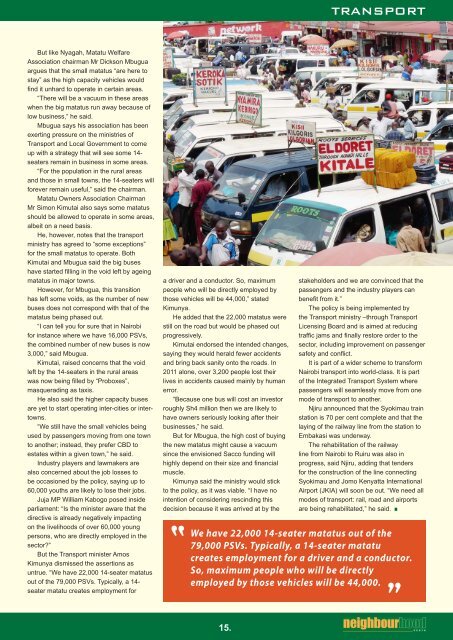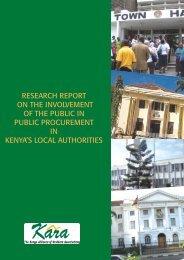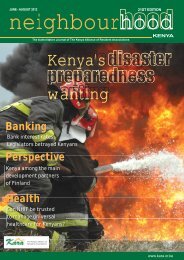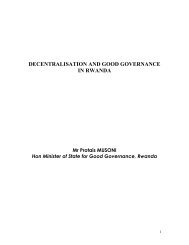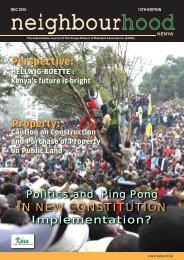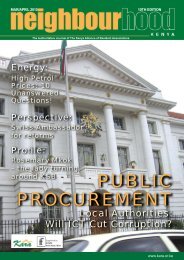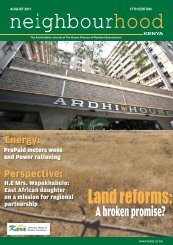Neighbourhood Kenya 20th Edition - Kara
Neighbourhood Kenya 20th Edition - Kara
Neighbourhood Kenya 20th Edition - Kara
You also want an ePaper? Increase the reach of your titles
YUMPU automatically turns print PDFs into web optimized ePapers that Google loves.
TRANSPORT<br />
But like Nyagah, Matatu Welfare<br />
Association chairman Mr Dickson Mbugua<br />
argues that the small matatus “are here to<br />
stay” as the high capacity vehicles would<br />
fi nd it unhard to operate in certain areas.<br />
“There will be a vacuum in these areas<br />
when the big matatus run away because of<br />
low business,” he said.<br />
Mbugua says his association has been<br />
exerting pressure on the ministries of<br />
Transport and Local Government to come<br />
up with a strategy that will see some 14-<br />
seaters remain in business in some areas.<br />
“For the population in the rural areas<br />
and those in small towns, the 14-seaters will<br />
forever remain useful,” said the chairman.<br />
Matatu Owners Association Chairman<br />
Mr Simon Kimutai also says some matatus<br />
should be allowed to operate in some areas,<br />
albeit on a need basis.<br />
He, however, notes that the transport<br />
ministry has agreed to “some exceptions”<br />
for the small matatus to operate. Both<br />
Kimutai and Mbugua said the big buses<br />
have started fi lling in the void left by ageing<br />
matatus in major towns.<br />
However, for Mbugua, this transition<br />
has left some voids, as the number of new<br />
buses does not correspond with that of the<br />
matatus being phased out.<br />
“I can tell you for sure that in Nairobi<br />
for instance where we have 16,000 PSVs,<br />
the combined number of new buses is now<br />
3,000,” said Mbugua.<br />
Kimutai, raised concerns that the void<br />
left by the 14-seaters in the rural areas<br />
was now being fi lled by “Proboxes”,<br />
masquerading as taxis.<br />
He also said the higher capacity buses<br />
are yet to start operating inter-cities or intertowns.<br />
“We still have the small vehicles being<br />
used by passengers moving from one town<br />
to another; instead, they prefer CBD to<br />
estates within a given town,” he said.<br />
Industry players and lawmakers are<br />
also concerned about the job losses to<br />
be occasioned by the policy, saying up to<br />
60,000 youths are likely to lose their jobs.<br />
Juja MP William Kabogo posed inside<br />
parliament: “Is the minister aware that the<br />
directive is already negatively impacting<br />
on the livelihoods of over 60,000 young<br />
persons, who are directly employed in the<br />
sector”<br />
But the Transport minister Amos<br />
Kimunya dismissed the assertions as<br />
untrue. “We have 22,000 14-seater matatus<br />
out of the 79,000 PSVs. Typically, a 14-<br />
seater matatu creates employment for<br />
a driver and a conductor. So, maximum<br />
people who will be directly employed by<br />
those vehicles will be 44,000,” stated<br />
Kimunya.<br />
He added that the 22,000 matatus were<br />
still on the road but would be phased out<br />
progressively.<br />
Kimutai endorsed the intended changes,<br />
saying they would herald fewer accidents<br />
and bring back sanity onto the roads. In<br />
2011 alone, over 3,200 people lost their<br />
lives in accidents caused mainly by human<br />
error.<br />
“Because one bus will cost an investor<br />
roughly Sh4 million then we are likely to<br />
have owners seriously looking after their<br />
businesses,” he said.<br />
But for Mbugua, the high cost of buying<br />
the new matatus might cause a vacuum<br />
since the envisioned Sacco funding will<br />
highly depend on their size and fi nancial<br />
muscle.<br />
Kimunya said the ministry would stick<br />
to the policy, as it was viable. “I have no<br />
intention of considering rescinding this<br />
decision because it was arrived at by the<br />
stakeholders and we are convinced that the<br />
passengers and the industry players can<br />
benefi t from it.”<br />
The policy is being implemented by<br />
the Transport ministry –through Transport<br />
Licensing Board and is aimed at reducing<br />
traffi c jams and fi nally restore order to the<br />
sector, including improvement on passenger<br />
safety and confl ict.<br />
It is part of a wider scheme to transform<br />
Nairobi transport into world-class. It is part<br />
of the Integrated Transport System where<br />
passengers will seamlessly move from one<br />
mode of transport to another.<br />
Njiru announced that the Syokimau train<br />
station is 70 per cent complete and that the<br />
laying of the railway line from the station to<br />
Embakasi was underway.<br />
The rehabilitation of the railway<br />
line from Nairobi to Ruiru was also in<br />
progress, said Njiru, adding that tenders<br />
for the construction of the line connecting<br />
Syokimau and Jomo <strong>Kenya</strong>tta International<br />
Airport (JKIA) will soon be out. “We need all<br />
modes of transport: rail, road and airports<br />
are being rehabilitated,” he said.<br />
We have 22,000 14-seater matatus out of the<br />
79,000 PSVs. Typically, a 14-seater matatu<br />
creates employment for a driver and a conductor.<br />
So, maximum people who will be directly<br />
employed by those vehicles will be 44,000.<br />
15.


